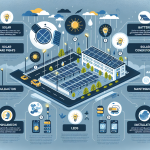Installation and Maintenance of Solar Carpark Lights
-
Table of Contents
Installation and maintenance of solar carpark lights are critical processes that ensure the effective and efficient operation of these sustainable lighting solutions. Solar carpark lights harness solar energy through photovoltaic panels, converting sunlight into electricity to power LED lights, providing illumination for parking areas without relying on the traditional power grid. The installation process involves selecting appropriate locations with maximum sun exposure, securely mounting the solar panels and light fixtures, and ensuring proper electrical connections and system configurations. Maintenance includes regular cleaning of solar panels to remove dust and debris, checking battery health and performance, inspecting light fixtures for damage, and ensuring all components are functioning correctly. Proper installation and diligent maintenance are essential to maximize the lifespan, reliability, and performance of solar carpark lights, contributing to energy savings and environmental sustainability.
Benefits Of Installing Solar Carpark Lights
The installation and maintenance of solar carpark lights offer numerous benefits that extend beyond mere illumination. One of the most significant advantages is the enhancement of safety and security. Well-lit carparks deter criminal activities, providing a safer environment for both vehicles and pedestrians. The consistent and reliable lighting ensures that individuals feel secure when accessing their vehicles, particularly during late hours. This sense of security is invaluable for businesses and public spaces, as it fosters a welcoming atmosphere and encourages patronage.
In addition to safety, solar carpark lights contribute to substantial cost savings. Traditional lighting systems rely on grid electricity, which incurs ongoing utility expenses. Solar lights, on the other hand, harness energy from the sun, significantly reducing electricity bills. The initial investment in solar technology is offset by the long-term savings on energy costs. Furthermore, solar lights require minimal maintenance compared to conventional lighting systems. With fewer components susceptible to wear and tear, the maintenance costs are considerably lower, making solar carpark lights a cost-effective solution in the long run.
Environmental sustainability is another compelling benefit of solar carpark lights. By utilizing renewable energy, these lights reduce the carbon footprint associated with traditional lighting methods. The reduction in greenhouse gas emissions aligns with global efforts to combat climate change and promotes a greener, more sustainable future. Businesses and organizations that adopt solar lighting demonstrate their commitment to environmental stewardship, enhancing their reputation and appeal to eco-conscious consumers.
The versatility and adaptability of solar carpark lights also deserve mention. These lights can be installed in various locations without the need for extensive wiring or trenching, which is often required for traditional lighting systems. This flexibility allows for quick and easy installation, minimizing disruption to the carpark area. Additionally, solar lights can be strategically placed to optimize illumination, ensuring that all areas of the carpark are adequately lit. This adaptability is particularly beneficial for remote or off-grid locations where access to electricity is limited or non-existent.
Moreover, solar carpark lights are equipped with advanced technology that enhances their functionality. Many models feature motion sensors and dimming capabilities, which optimize energy usage and extend the lifespan of the lights. Motion sensors ensure that the lights are only activated when movement is detected, conserving energy during periods of inactivity. Dimming capabilities allow the lights to operate at reduced brightness when full illumination is not necessary, further conserving energy and prolonging the operational life of the lighting system.
In conclusion, the benefits of installing solar carpark lights are multifaceted, encompassing safety, cost savings, environmental sustainability, versatility, and advanced technological features. These advantages make solar carpark lights an attractive option for businesses, public spaces, and remote locations. By investing in solar lighting, organizations not only enhance the safety and security of their carparks but also contribute to a more sustainable and cost-effective future. The transition to solar carpark lights represents a forward-thinking approach that aligns with contemporary values of environmental responsibility and economic efficiency.
Step-By-Step Guide To Installing Solar Carpark Lights

Installing solar carpark lights is a sustainable and cost-effective solution for illuminating parking areas. The process involves several critical steps, each requiring careful attention to detail to ensure optimal performance and longevity. This guide provides a comprehensive overview of the installation and maintenance of solar carpark lights, facilitating a seamless transition from planning to execution.
To begin with, the initial step in installing solar carpark lights is site assessment. This involves evaluating the location to determine the most suitable spots for light installation. Factors such as the amount of sunlight the area receives, potential obstructions, and the layout of the carpark must be considered. Conducting a thorough site assessment ensures that the solar panels receive maximum sunlight, which is crucial for their efficiency.
Following the site assessment, the next step is selecting the appropriate solar carpark lights. It is essential to choose lights that are specifically designed for outdoor use and are capable of withstanding various weather conditions. Additionally, the lights should have a sufficient lumen output to provide adequate illumination for the carpark. Once the appropriate lights have been selected, the installation process can commence.
The installation process begins with the preparation of the mounting poles. These poles must be securely anchored into the ground to ensure stability. It is advisable to use concrete foundations for the poles to provide a solid base. After the poles are in place, the solar panels can be mounted on top. It is crucial to position the panels at an angle that maximizes their exposure to sunlight. Typically, a tilt angle equal to the latitude of the location is recommended.
Subsequently, the solar lights themselves are installed. This involves attaching the light fixtures to the mounting poles and connecting them to the solar panels. It is important to follow the manufacturer’s instructions carefully during this step to ensure proper wiring and secure connections. Once the lights are installed, they should be tested to verify that they are functioning correctly. This includes checking the brightness of the lights and ensuring that they turn on and off automatically based on the ambient light levels.
After the installation is complete, regular maintenance is essential to ensure the longevity and efficiency of the solar carpark lights. One of the primary maintenance tasks is cleaning the solar panels. Dust, dirt, and debris can accumulate on the panels, reducing their ability to absorb sunlight. Cleaning the panels periodically with a soft cloth and mild detergent can help maintain their efficiency. Additionally, it is important to inspect the light fixtures and wiring regularly for any signs of damage or wear. Any damaged components should be repaired or replaced promptly to prevent further issues.
Furthermore, the batteries that store the solar energy should be checked periodically. Over time, batteries can lose their capacity to hold a charge, which can affect the performance of the lights. Replacing the batteries as needed ensures that the lights continue to operate efficiently. It is also advisable to monitor the overall performance of the solar carpark lights and make any necessary adjustments to the positioning of the panels or light fixtures to optimize their effectiveness.
In conclusion, the installation and maintenance of solar carpark lights involve a series of well-defined steps, from site assessment and selection of appropriate lights to the actual installation and ongoing maintenance. By following these steps meticulously, one can ensure that the solar carpark lights provide reliable and efficient illumination for an extended period, contributing to a sustainable and cost-effective lighting solution.
Maintenance Tips For Long-Lasting Solar Carpark Lights
To ensure the longevity and optimal performance of solar carpark lights, it is essential to adhere to a comprehensive maintenance regimen. Regular maintenance not only extends the lifespan of the lights but also ensures consistent illumination, which is crucial for safety and security. One of the primary aspects of maintaining solar carpark lights is the periodic cleaning of solar panels. Dust, dirt, and debris can accumulate on the panels, significantly reducing their efficiency. Therefore, it is advisable to clean the panels at least once every three months using a soft cloth and mild detergent. This simple step can enhance the panels’ ability to absorb sunlight, thereby improving the overall performance of the lights.
In addition to cleaning the solar panels, it is important to inspect the batteries regularly. The batteries are a critical component of solar carpark lights, as they store the energy harnessed from the sun. Over time, batteries can degrade, leading to reduced storage capacity and shorter lighting durations. To mitigate this issue, it is recommended to check the batteries every six months and replace them if necessary. Using high-quality, long-lasting batteries can also contribute to the overall efficiency and reliability of the solar lighting system.
Another crucial maintenance tip involves the examination of the light fixtures themselves. Regularly inspecting the fixtures for any signs of wear and tear, such as cracks or corrosion, can prevent potential malfunctions. If any damage is detected, it should be addressed promptly to avoid further complications. Additionally, ensuring that the light fixtures are securely mounted and properly aligned can enhance their effectiveness in illuminating the carpark area.
Furthermore, it is essential to monitor the performance of the solar carpark lights periodically. This can be done by observing the lights during different times of the day and night to ensure they are functioning correctly. If any inconsistencies or malfunctions are noticed, it may be necessary to troubleshoot the system. Common issues could include faulty wiring, loose connections, or problems with the solar controller. Addressing these issues promptly can prevent more significant problems and ensure the continuous operation of the lights.
Moreover, it is beneficial to keep an eye on the surrounding environment. Overgrown vegetation or newly constructed structures can cast shadows on the solar panels, reducing their exposure to sunlight. Regularly trimming trees and bushes around the carpark area can help maintain optimal sunlight absorption. Additionally, if any new structures are planned, it is important to consider their potential impact on the solar lighting system and make necessary adjustments to the placement of the panels.
Lastly, it is advisable to keep a maintenance log for the solar carpark lights. Documenting all maintenance activities, including cleaning, inspections, and battery replacements, can provide valuable insights into the system’s performance over time. This log can also help identify recurring issues and inform future maintenance strategies.
In conclusion, maintaining solar carpark lights involves a combination of regular cleaning, battery inspections, fixture examinations, performance monitoring, and environmental management. By adhering to these maintenance tips, one can ensure the long-lasting and efficient operation of solar carpark lights, thereby enhancing the safety and security of the carpark area.
Read more about Solar Carpark Lights:
- Introduction to Solar Carpark Lights
- Types of Solar Carpark Lights
- Factors to Consider when Choosing Solar Carpark Lights
- Top Brands in the Solar Carpark Light Industry
- Innovative Features of Solar Carpark Lights
- Case Studies: Successful Implementation of Solar Carpark Lights
- Practical Applications of Solar Carpark Lights
- Future Developments in Solar Carpark Lights
- Frequently Asked Questions about Solar Carpark Lights









